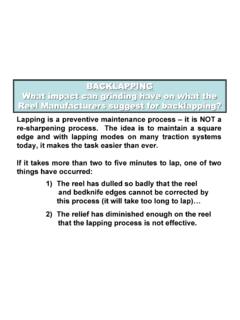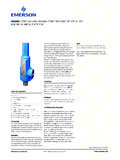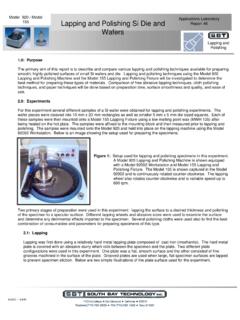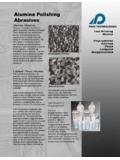Transcription of TUFFTRIDE -/QPQ -PROCESS - Houston Unlimited Inc
1 TUFFTRIDE -/QPQ -PROCESSDr. Joachim Bo let / Michael KreutzTechnical InformationTUFFTRIDE -/QPQ -ProcessSalt bath nitrocarburizing by the TUFFTRIDE processhas been applied in a wide range of industries through-out the world for many decades. It is used to improve thewear resistance, the fatigue strength and in particularwhen combined with the oxidative cooling the corro-sion resistance of components made from steel, castiron and sintered iron materials. In many cases theTUFFTRIDE process is used as an alternative to othersurface engineering processes such as case hardening,galvanic ( hard chrome plating), and other coatingprocesses (plastic coating, painting, laser coating etc.)
2 ,also plasma or gas nitrocarburizing with equally good orimproved quality and greater out the processCompared with other nitrocarburizingprocesses, the TUFFTRIDE ,andQPQ process are very easy to carryout. As is usual when treating compo-nents in salt baths, the parts are firstpreheated to about 350 C in takes place in a socalled TF 1 bath at 480 - 630 C, thestandard temperature is usually580 salt melt mainly consists ofalkali cyanate and alkali is operated in a pot made fromspecial material, and the pot is fit-ted with an aeration device. Theactive constituent in the TF 1 bathis the alkali cyanate.
3 During thenitrocarburizing process a reactiontakes place between the surface ofthe components and the alkalicyanate, resulting in the formation of alkali carbonate. Byadding specific amounts of the non-toxic regeneratorREG 1, the nitriding active constituents are again produced in the salt melt and the activity of the TF 1 bathis kept within very strict tolerances (Fig. 1). TUFFTRIDE and QPQ are registered trademarks ofDurferrit + Fig. 1As the regeneration takes place without any change inthe volume of the nitrocarburizing bath, part of the meltdoes not have to be bailed out. Drag-out losses whichoccur when the parts are removed from the bath aresupplemented with TF 1 replenisher salt.
4 Unlike gasnitriding or gas nitrocarburizing, the products TF 1and REG 1 - needed for the TUFFTRIDE and QPQ process , do not contain constituents classified as toxicor harmful to the specially developed cooling bath (AB 1 bath) is usedfor carrying out the oxidative treatment after salt bathnitrocarburizing. During this treatment a black iron oxidelayer (magnetite) is produced on the surface of the treatedparts, which greatly enhances the corrosion temperature of the cooling bath is 370-420 C. Apartfrom the oxidative effect, the salt melt has a positive influence on the dimensional stability of the cooled , the parts are cooled to room temperature andthen cleaned ( TUFFTRIDE process ).
5 If the surface of the components after nitrocarburizing isnot smooth enough for certain applications, dependingon the size and shape of the parts, various polishingmethods can be used to reduce the roughness. Someproven methods are: Lapping with emery cloth grade 360 or finer; Polishing or continuous microfinishing with special plastic discs similar to centreless polishing, or on an automated lathe fixed between centre pieces or clamped in; Polishing in a vibrating drum. This method is primarilyused for small and thin parts; Blasting with glass beads size 40-70 m in diameter. To prevent edges being excessively rounded off, or the thickness of the compound layer reduced, the pressure should not exceed 4 bar; Automated blasting with metal shot, if possible the diameter should be less than 1 processing can, however, may partly reducethe corrosion resistance gained.
6 For this reason, in manycases an oxidative post treatment in an AB 1 bath is carried out after complete process sequence is shown in Fig. 2 andis in fact the QPQ process . QPQ comprisesTUFFTRIDE treatment with oxidative cooling, mechani-cal processing and oxidative post treatment in a andthickness of thenitride layerCompound layerDuring salt bath nitrocarburizing bythe TUFFTRIDE process a nitro-carburized layer is formed consist-ing of the outer compound layer ( -iron nitride) and the diffusion layerthereunder. The formation, micro-structure and properties of thecompound layer are determined bythe base compound layer consists ofcompounds of iron, nitrogen, car-bon and oxygen.
7 Due to itsmicrostructure, the compoundlayer does not possess metallicproperties. It is particularly resis-tant to wear, seizure and corro-sion, as well as being stablealmost to the temperature atwhich it was formed. Comparedwith plasma or gas nitrocarburiz-ing, compound layers with thehighest nitrogen content can beobtained by the TUFFTRIDE process . Layers with a high nitro-gen content give better protectionagainst wear, and in particular corrosion, than those with a on the material used,the compound layer will have aVickers hardness of about 800 to1500 HV.
8 Fig. 3 shows a compari-son of the surface layers producedby various processes and !" $ $ % % & &' & ( $ ) *+,-..// Fig. 2 !! !!!" !!"!!! !!! Fig. 3In the metallographic analysis of salt bath nitrocarburizedcomponents, that part of the total layer known as thecompound layer is defined clearly from the diffusion layerthereunder as a slightly etched zone. During the diffusionof atomic nitrogen the compound layer is formed. Thegrowing level of nitrogen results in the limit of solubility inthe surface zone being exceeded, which causes thenitrides to precipitate and form a closed compound addition to the treatment parameters (temperature,duration, bath composition), the levels of carbon andalloying elements in the materials to be treated influencethe thickness of layer obtainable.
9 Although the growth of the layer is lower the higher the content of alloy, thehardness however increases to an equal data shown in Fig. 4 weredetermined in a TF 1 bath at580 C. With the usual treatingdurations of 60-120 minutes, thecompound layer obtained was10-20 m thick on most qualitiesof layerThe depth and hardness of thediffusion layer are largely deter-mined by the material. The higherthe alloying content in the steel,the lower the nitrogen penetrationdepth at equal treating the other hand, the hardnessincreases the higher the the case of unalloyed steels, the crystalline structure ofthe diffusion layer is influenced by the rate of cooling afternitrocarburizing.
10 After rapid cooling in water, the diffusednitrogen remains in solution. If cooling is done slowly, orif a subsequent tempering is carried out, some of thenitrogen could precipitate into iron nitride needles in theouter region of the diffusion layer of unalloyed steels. Thisprecipitation improves the ductility of nitrocarburizedcomponents. Unlike unalloyed steels, part of the diffusion layer of high alloyed materials can be betteridentified metallographically from the core structure, dueto the improved etchability. 4 Compound layer thickness in m Treating time in the TF 1 - bath (in hrs) Fig. 4 But the actual nitrogen penetrationis also considerably deeper than thedarker etched area visible does not influence the for-mation of the diffusion layer to anynoteworthy extent.






